Plastic countertops in the kitchen: design options and selection rules
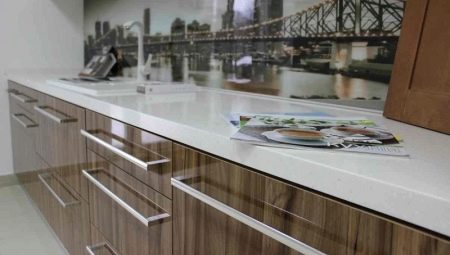
Not everyone can afford even the cheapest artificial stone countertop. So that the kitchen does not look worse than others, they buy a plastic one.
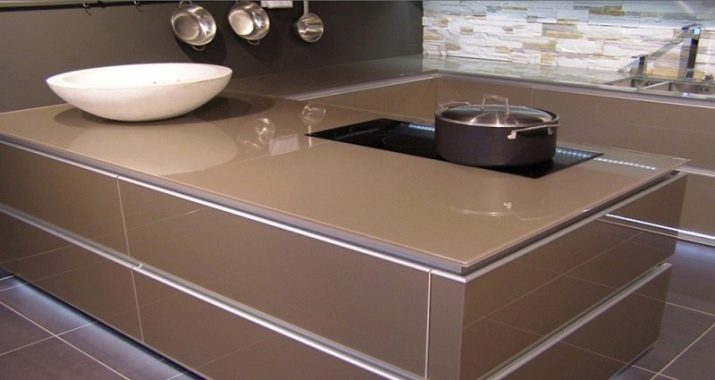
Manufacturing features
The basis of a plastic kitchen countertop - chipboard (less often fiberboard) boards of different thicknesses with a layer of plastic. A reliable connection between them is achieved by applying pressure and high temperature. Using the postforming method, the finishing layer bends and smoothly flows around the leading edge, forming a perfectly smooth surface.
The plastic countertop has a decorative and protective melamine finish. Decorate it with any pattern using the digital printing method. They even imitate the natural structures of luxury wood or granite. The topmost layer applied over the picture can be matte, glossy or "rough".
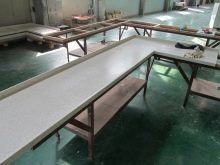
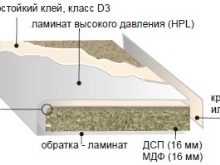
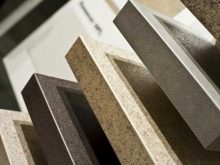
Advantages and disadvantages
At the kitchen countertop made of plastic there are undeniable advantages:
- affordable price (a square meter costs from 1000 to 4000 rubles);
- easy maintenance (even a brush and a cleaning agent with abrasives are used to clean the dirt);
- does not fade under the influence of ultraviolet rays;
- heat resistance (short-term contact with hot water, whose temperature is 180-230 ° C, does not destroy or render unusable the chosen countertop with love);
- immunity to moisture;
- easy assembly and disassembly;
- variety of textures and colors.
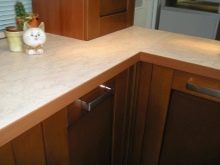
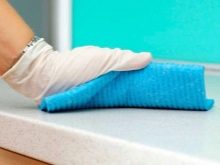

Along with the merits, it has serious disadvantages:
- upon detailed examination, they can easily distinguish a plastic countertop from a marble or granite countertop;
- formaldehyde can be released through the damaged end, which has a toxic effect;
- the countertop swells if moisture gets into the damaged area;
- there will always be noticeable seams on the countertop of a corner kitchen unit.
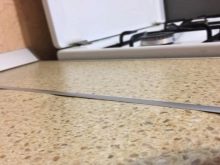
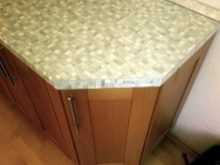
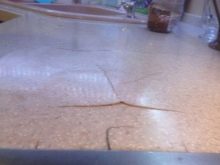
Subtleties of purchase
A finished PVC product made from laminated boards is often bought. They are produced in Russia and Europe. Housewives choose the right one from the assortment of the hardware store. Often, among those presented, they do not find what they want. In this case, they turn to furniture shops that specialize in the production of countertops.
Buying from them will not be cheap, but they will make it in the right size and with the desired design.
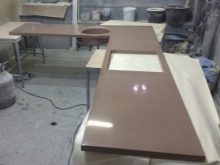
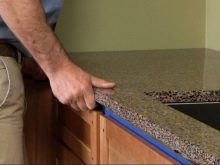
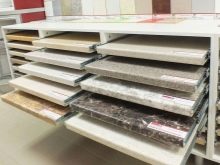
The foundation
Choosing a stove for a countertop, they are convinced of its absolute safety for health. It doesn't have to be toxic. The suitable emission class is E1. Bona fide sellers in Russia have a certificate of conformity or a conclusion of Rospotrebnadzor for their products.
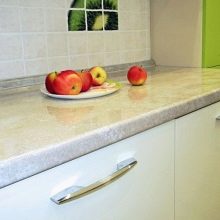
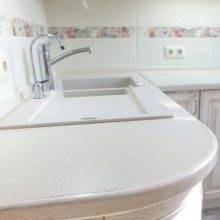
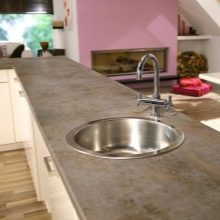
It is important to determine whether the countertop was made of moisture-resistant chipboard or not. Since the kitchen is a place of high humidity, ordinary chipboard will quickly deteriorate. It is easy to distinguish a moisture-resistant material from a non-moisture resistant material. To do this, it is enough to inspect the break. If you see a greenish tint, then the chipboard is moisture resistant. In the absence of a break, moisture resistance is determined by price: an ordinary chipboard is several times cheaper.
To prevent moisture from getting into the places of seams and joints, they are treated in workshops with silicone sealant or hidden behind an aluminum profile. Sometimes they use another version of their processing called eurozapil: the seams are made invisible, duplicating the joints with clamping screws and smearing the joints with glue-sealant. Eurozapil is made on a finished product, but they ask for it up to 4000 rubles.

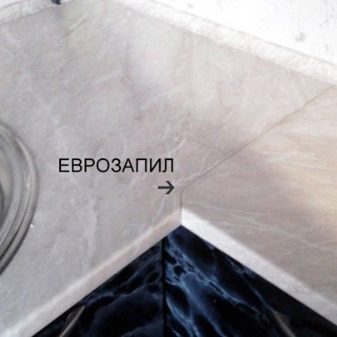
The size
The countertop is not bought at random - it is selected for the kitchen, based on its size. Household preferences are also taken into account. The optimal slab thickness is 38 (40) or 26 (28) mm. The first is more durable, and the second is more budgetary in price (50% cheaper than a "thick" plate). Rarely buy a countertop with a slab thickness of 60 mm, but it is more solid and moisture resistant.
The standard width of the table top is 600 mm. It depends on the size of the kitchen. If desired, reduce it to 300 or increase it to 1200 mm, if made to order.
The length of the product can be any, but more often up to 4200 mm. When deciding on this parameter, they try to ensure that there are no seams or there are few.
If there are no seams, then moisture will not get into them, the plate will not swell.
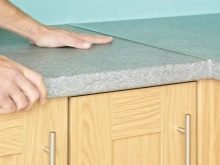
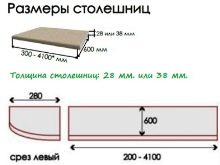
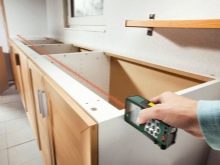
Design
The design of the plastic table top can be any. The practicality of use and the price directly depend on which option the hostess will like. If a product with a standard design does not appeal to you, they contact the furniture workshop.
If there are many options for decorating the surface of the desktop (both in color and in pattern), then there are only three textures.
- Glossy. It is smart and showy, but fingerprints and greasy stains are more visible on it than on any other surface.
- Textured. The product imitates a stone or wooden surface. With its help, they create coziness in the kitchen, choosing furniture or accessories for the design. The only caveat: because of the texture, caring for such a tabletop is troublesome.
- Matt. The matte plastic worktop is the best and the least picky to care for. If they accidentally scratch it or smear it with dirty hands, the rough surface will hide unsightly marks from prying eyes.
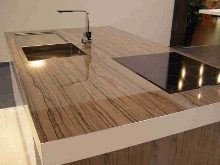
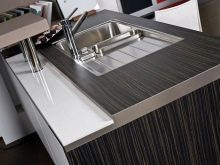

When choosing a tone for the countertop, they are repelled by the colors used in the design of the kitchen and the practicality of use. In tone, it can be dark or light.
The light surface is not as spectacular as the dark one, but it does not show fingerprints or minor scratches.
On a dark surface, any flaws that appear during operation are distinguished. To correct this deficiency, it is recommended to choose smooth products of brown, beige or gray color that imitate natural stone.Dark or light specks will reliably hide any traces of activity in the kitchen.
Solid color countertops complement kitchens that are designed in minimalist styles.
If you buy a product with a picture, then it will acquire a special comfort and individuality.
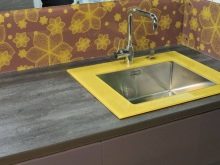

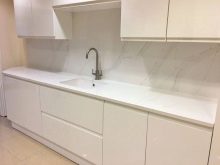
The choice of plastic for decoration
The quality and service life of the product depend on the thickness of the last layer of plastic. In Germany and Italy, tabletops are produced with a thickness of 0.8 mm, and in Russia and Poland - 0.4-0.5 mm. The thicker it is, the less frightening the surface is by external stimuli.
If the countertop is light, but the last layer of plastic is thick, it will not lose its presentability after the first accidentally spilled cup of tea. It is preferable to choose durable, several layers of quality kraft paper, impregnated with resins and press-molded HPL, rather than CPL plastic, which fade under the influence of sunlight and is easily scratched.
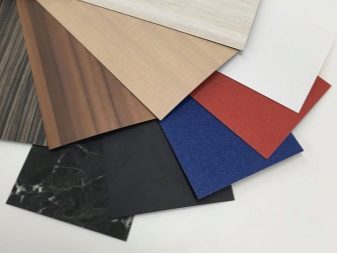
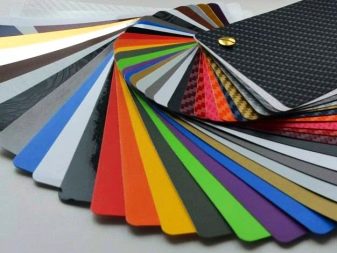
Edge swelling protection
The ideal option for the kitchen is a worktop with a cut out edge from an aluminum profile. Less persistent processing options:
- edge plastic (when they want the edge to match the color of the tabletop itself);
- 3d acrylic edge (when looking for a product with an individual design);
- PVC edge (when affordable price is above all).
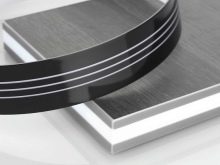
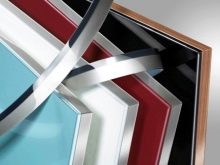
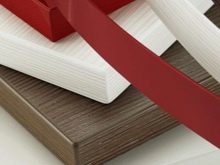
Additional protection
The service life of the table top is extended by installing additional protection. A drip tray is mounted in the lower part of the plate, preventing liquid from entering under it. If the product does not fit tightly to the wall, they buy a plinth and decorate it with a removable strip.
The ideal option for high-tech kitchens is a metal skirting board.
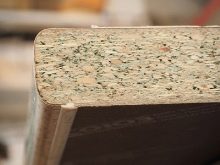
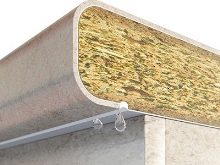
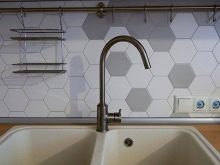
Care
To prevent the slab from swelling, moisture is removed from it in a timely manner, preventing it from being absorbed. Due to water currents, do not place wet dishes close to the sides of the sink. Do not beat, chop or cut food on the plastic countertop. Otherwise, the damaged layer of the laminate will be hopelessly damaged. For the same reason, do not defrost food on it.
The most affordable countertop option is plastic. She has a wide selection of colors, textures and styles. It fits into any interior, but caring for it is more laborious than for a polymer one.
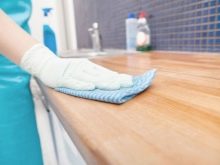
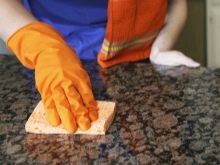
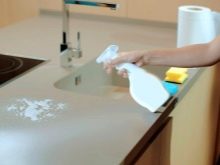
You can find out which plastic countertop to choose from the video below.








